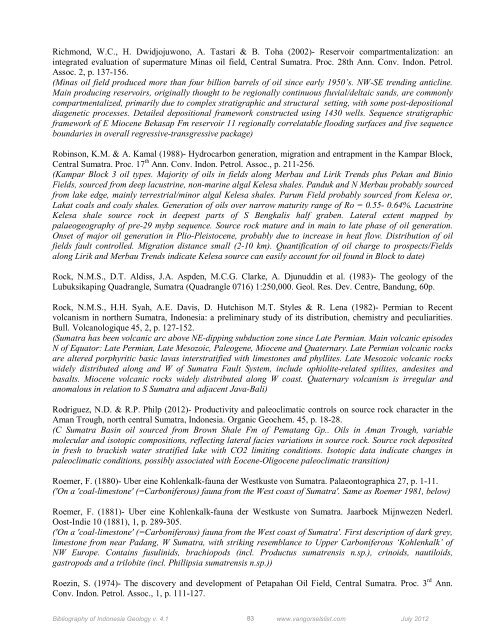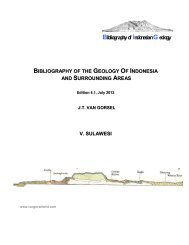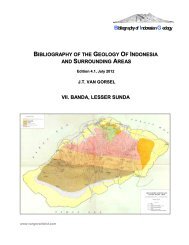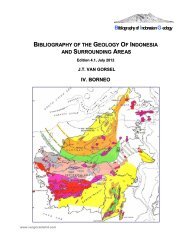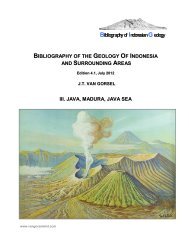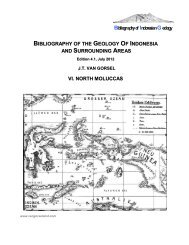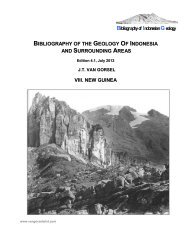Sumatra, Sunda Shelf, Natuna - Bibliography of Indonesia Geology
Sumatra, Sunda Shelf, Natuna - Bibliography of Indonesia Geology
Sumatra, Sunda Shelf, Natuna - Bibliography of Indonesia Geology
You also want an ePaper? Increase the reach of your titles
YUMPU automatically turns print PDFs into web optimized ePapers that Google loves.
Richmond, W.C., H. Dwidjojuwono, A. Tastari & B. Toha (2002)- Reservoir compartmentalization: an<br />
integrated evaluation <strong>of</strong> supermature Minas oil field, Central <strong>Sumatra</strong>. Proc. 28th Ann. Conv. Indon. Petrol.<br />
Assoc. 2, p. 137-156.<br />
(Minas oil field produced more than four billion barrels <strong>of</strong> oil since early 1950’s. NW-SE trending anticline.<br />
Main producing reservoirs, originally thought to be regionally continuous fluvial/deltaic sands, are commonly<br />
compartmentalized, primarily due to complex stratigraphic and structural setting, with some post-depositional<br />
diagenetic processes. Detailed depositional framework constructed using 1430 wells. Sequence stratigraphic<br />
framework <strong>of</strong> E Miocene Bekasap Fm reservoir 11 regionally correlatable flooding surfaces and five sequence<br />
boundaries in overall regressive-transgressive package)<br />
Robinson, K.M. & A. Kamal (1988)- Hydrocarbon generation, migration and entrapment in the Kampar Block,<br />
Central <strong>Sumatra</strong>. Proc. 17 th Ann. Conv. Indon. Petrol. Assoc., p. 211-256.<br />
(Kampar Block 3 oil types. Majority <strong>of</strong> oils in fields along Merbau and Lirik Trends plus Pekan and Binio<br />
Fields, sourced from deep lacustrine, non-marine algal Kelesa shales. Panduk and N Merbau probably sourced<br />
from lake edge, mainly terrestrial/minor algal Kelesa shales. Parum Field probably sourced from Kelesa or,<br />
Lakat coals and coaly shales. Generation <strong>of</strong> oils over narrow maturity range <strong>of</strong> Ro = 0.55- 0.64%. Lacustrine<br />
Kelesa shale source rock in deepest parts <strong>of</strong> S Bengkalis half graben. Lateral extent mapped by<br />
palaeogeography <strong>of</strong> pre-29 mybp sequence. Source rock mature and in main to late phase <strong>of</strong> oil generation.<br />
Onset <strong>of</strong> major oil generation in Plio-Pleistocene, probably due to increase in heat flow. Distribution <strong>of</strong> oil<br />
fields fault controlled. Migration distance small (2-10 km). Quantification <strong>of</strong> oil charge to prospects/Fields<br />
along Lirik and Merbau Trends indicate Kelesa source can easily account for oil found in Block to date)<br />
Rock, N.M.S., D.T. Aldiss, J.A. Aspden, M.C.G. Clarke, A. Djunuddin et al. (1983)- The geology <strong>of</strong> the<br />
Lubuksikaping Quadrangle, <strong>Sumatra</strong> (Quadrangle 0716) 1:250,000. Geol. Res. Dev. Centre, Bandung, 60p.<br />
Rock, N.M.S., H.H. Syah, A.E. Davis, D. Hutchison M.T. Styles & R. Lena (1982)- Permian to Recent<br />
volcanism in northern <strong>Sumatra</strong>, <strong>Indonesia</strong>: a preliminary study <strong>of</strong> its distribution, chemistry and peculiarities.<br />
Bull. Volcanologique 45, 2, p. 127-152.<br />
(<strong>Sumatra</strong> has been volcanic arc above NE-dipping subduction zone since Late Permian. Main volcanic episodes<br />
N <strong>of</strong> Equator: Late Permian, Late Mesozoic, Paleogene, Miocene and Quaternary. Late Permian volcanic rocks<br />
are altered porphyritic basic lavas interstratified with limestones and phyllites. Late Mesozoic volcanic rocks<br />
widely distributed along and W <strong>of</strong> <strong>Sumatra</strong> Fault System, include ophiolite-related spilites, andesites and<br />
basalts. Miocene volcanic rocks widely distributed along W coast. Quaternary volcanism is irregular and<br />
anomalous in relation to S <strong>Sumatra</strong> and adjacent Java-Bali)<br />
Rodriguez, N.D. & R.P. Philp (2012)- Productivity and paleoclimatic controls on source rock character in the<br />
Aman Trough, north central <strong>Sumatra</strong>, <strong>Indonesia</strong>. Organic Geochem. 45, p. 18-28.<br />
(C <strong>Sumatra</strong> Basin oil sourced from Brown Shale Fm <strong>of</strong> Pematang Gp.. Oils in Aman Trough, variable<br />
molecular and isotopic compositions, reflecting lateral facies variations in source rock. Source rock deposited<br />
in fresh to brackish water stratified lake with CO2 limiting conditions. Isotopic data indicate changes in<br />
paleoclimatic conditions, possibly associated with Eocene-Oligocene paleoclimatic transition)<br />
Roemer, F. (1880)- Uber eine Kohlenkalk-fauna der Westkuste von <strong>Sumatra</strong>. Palaeontographica 27, p. 1-11.<br />
('On a 'coal-limestone' (=Carboniferous) fauna from the West coast <strong>of</strong> <strong>Sumatra</strong>'. Same as Roemer 1981, below)<br />
Roemer, F. (1881)- Uber eine Kohlenkalk-fauna der Westkuste von <strong>Sumatra</strong>. Jaarboek Mijnwezen Nederl.<br />
Oost-Indie 10 (1881), 1, p. 289-305.<br />
('On a 'coal-limestone' (=Carboniferous) fauna from the West coast <strong>of</strong> <strong>Sumatra</strong>'. First description <strong>of</strong> dark grey,<br />
limestone from near Padang, W <strong>Sumatra</strong>, with striking resemblance to Upper Carboniferous ‘Kohlenkalk’ <strong>of</strong><br />
NW Europe. Contains fusulinids, brachiopods (incl. Productus sumatrensis n.sp.), crinoids, nautiloids,<br />
gastropods and a trilobite (incl. Phillipsia sumatrensis n.sp.))<br />
Roezin, S. (1974)- The discovery and development <strong>of</strong> Petapahan Oil Field, Central <strong>Sumatra</strong>. Proc. 3 rd Ann.<br />
Conv. Indon. Petrol. Assoc., 1, p. 111-127.<br />
<strong>Bibliography</strong> <strong>of</strong> <strong>Indonesia</strong> <strong>Geology</strong> v. 4.1 83 www.vangorselslist.com July 2012


